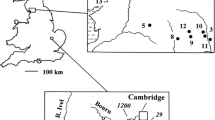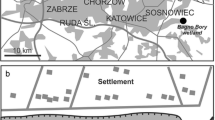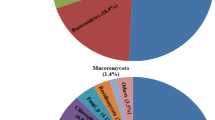Abstract
An account is given of the chemistry and vegetation of wet areas below the Elvins tailings pile in the Old Lead Belt of Missouri. Zinc in particular is present at highly elevated levels in the water (5.9–21.0 mg l−1) and most sediments. The two most widespread plants are a blue-green alga,Plectonema gracillimum, and a moss,Dicranella sp. In wetter areas the latter exists predominantly as protonema.Plectonema and the protonema typically grow in very close association, although situations do occur where only one or the other is present. For instance, algal flocs in two permanent ponds consisted largely ofPlectonema and unicellular blue-green algae, with a few eukaryotic algae, but no protonema. Other dominants in the area areEleocharis sp.,Scirpus americanus andTypha latifolia. One seepage was studied in more detail; it showed marked changes in both chemistry and vegetation on passing from source to a site 15 m downstream. Aqueous Zn dropped from 21 to 8 mg l−1. ThePlectonema-Dicranella protonema community predominated in the upper part, developing a laminated structure up to 3 cm thick (justifying recognition as a stromatolite). Further downstream a white crust including much hydrozincite and with a very high overall zinc content (c. 370 mg g−1 Zn) was deposited over the green layer, making it endolithic in position, though probably not in origin. Still further downstream the green layer disappeared, leaving only a hard white crust. A discussion is included of the extent to which observed variations in the zinc content of water and sediments below the tailings pile are influenced by living and dead plants. An apparent diel cycle in aqueous zinc at some sites is of particular interest, as it was not matched by changes in Ca or Cd.
Similar content being viewed by others
References
Bradshaw, A. D., 1975. The evolution of metal tolerance and its significance for vegetation establishment on metal contaminated sites. In: Symp. Proc., Int. Conf. Heavy Metals in the Environment, Ed. T. C. Hutchinson, Canada: Univ. of Toronto, 2(2): 599–622.
Brock, T. D., 1973. Evolutionary and ecological aspects of the cyanophytes. In: The Biology of Blue-green algae, Ed. N. G. Carr & B. A. Whitton, Oxford: Blackwell, pp. 487–500
Ernst, W., 1974. Schwermetall vegetation der Erde (= Geobotanica Selecta V). Stuttgart: Gustav Fischer, 194 pp.
Hem, J. D., 1972. Chemistry and occurrence of cadmium and zinc in surface water and groundwater. Water Resour. Res. 8: 661–679.
Holmes, N. T. H. & Whitton, B. A., 1981. Phytobenthos of the River Tees and its tributaries. Freshwater Biol.
Jennett, J. C. & Wixson, B. G., 1977. Water quality studies. T. Old Lead Belt studies. In: The Missouri Lead Study. An interdisciplinary investigation of environmental pollution by lead and other heavy metals from industrial development in the New Lead Belt of southeastern Missouri, Vol. 1. Ed. B. G. Wixson, Rolla and Columbia: Univ. of Missouri, pp. 350–368.
Kramer, R. L., 1976. Effects of a century old Missouri lead mining operation upon the water quality, sediments and biota of Flat River Creek. M. Sc. Thesis, Univ. Missouri-Rolla, 137 pp.
Parsons, A. B., 1974. The St. Joe enterprise. Min. Metall. 28: 4.
Ridge, J. D., Ed., 1968. Ore deposits of the United States, 1933–1967, New York, N.Y.: American Institute of Mining, Metallurgical and Petroleum Engineers, Inc.
Vineyard, J. D., Ed., 1972. Federal Mill closing last facility in the Old Lead Belt. Missouri Mineral News 12(5): 71.
Walter, M. R., 1976. Introduction. In: Stromatolites, Ed. M. R. Walter, Amsterdam, Oxford & N.Y.: Elsevier, pp. 1–3.
Whitton, B. A., 1980. Zinc and plants in rivers and streams. In: Zinc in the environment. Part II Health effects, Ed. J. O. Nriagu, New York, Chichester, Brisbane and Toronto: John Wiley & Sons, pp. 364–400.
Author information
Authors and Affiliations
Rights and permissions
About this article
Cite this article
Whitton, B.A., Gale, N.L. & Wixson, B.G. Chemistry and plant ecology of zinc-rich wastes dominated by blue-green algae. Hydrobiologia 83, 331–341 (1981). https://doi.org/10.1007/BF00008284
Received:
Issue Date:
DOI: https://doi.org/10.1007/BF00008284




